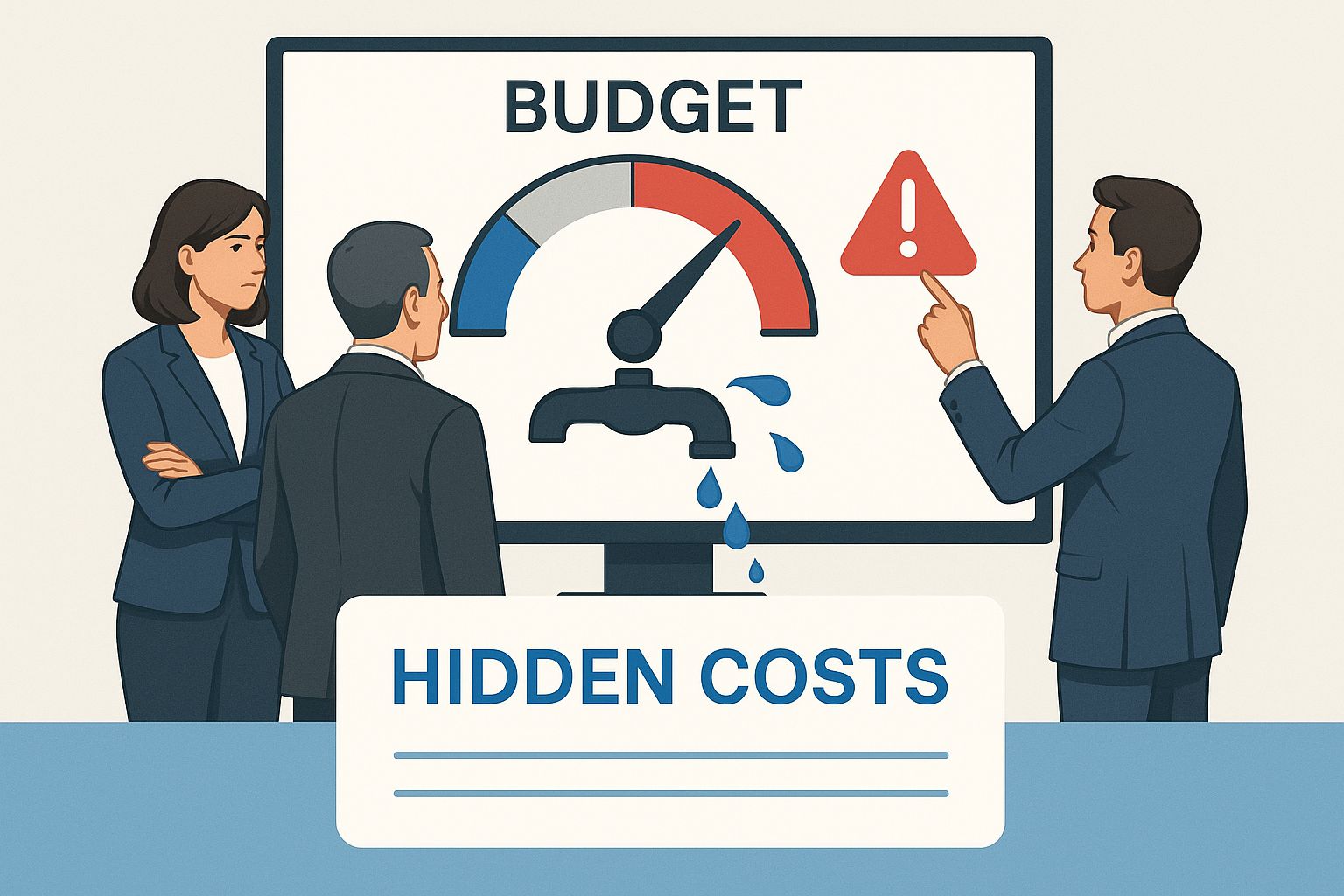- Why Project and Financial Goals Must Align
- Bridging the Operational and Financial Gap
- The Benefits of a Unified Approach
- Why Disconnected Teams Are Costing Your Business Money
- The Hidden Costs of Poor Integration
- The Downstream Impact on Profitability
- The Four Pillars of Integrated Project Financials
- 1. Unified Budgeting and Forecasting
- 2. Real-Time Cost Tracking
- 3. Accurate Profitability Analysis
- 4. Streamlined Invoicing and Payments
- Comparing Siloed vs Integrated Financial Workflows
- See It in Action: A Real-World Project Scenario
- Step 1: From Proposal to Project in a Single Click
- Step 2: Live Tracking and Proactive Decisions
- Step 3: Keeping a Pulse on Profitability
- Step 4: Invoicing with Accuracy and Speed
- Best Practices for a Seamless Integration
- Establish Clear Financial KPIs for Every Project
- Foster a Culture of Open Communication
- Provide Essential Financial Literacy Training
- How to Choose the Right Unified Platform
- Core Features You Cannot Live Without
- Key Questions to Ask During a Demo
- Got Questions? We’ve Got Answers
- How Can We Get a Better Handle on Finances Without a Huge Software Budget?
- What Are the Biggest Headaches When Merging These Two Functions?
- How Does Managing Money Better Actually Improve Client Relationships?
For any professional services firm, successfully weaving project management and finance together is the bedrock of profitability. It’s the critical difference between guessing if a project is on track and knowing it’s profitable, right now. This integration ensures every hour logged and every dollar spent connects directly to the project’s financial health.
Why Project and Financial Goals Must Align
Think of yourself as the captain of a ship. As the project manager, you’re at the helm, steering confidently toward your destination—project completion. But what about the fuel levels? The cost of supplies? The crew’s payroll? That’s where your finance team (or operaitonal software) comes in, acting as your trusted navigator and quartermaster.
For too long, many firms have let the captain and the navigator work from separate charts, often in completely different rooms.
This disconnected approach is like sailing blind. The captain might feel the ship is making incredible time, totally unaware that the fuel is about to run out. In the same way, a project manager can hit every single milestone right on schedule while the project is quietly bleeding money. That’s a mess the finance team might only uncover weeks later when they finally run the numbers. This gap between operational progress and financial reality is a huge, unnecessary risk.

Bridging the Operational and Financial Gap
At its heart, the problem is simple: project teams are laser-focused on deliverables and deadlines, while finance teams and directors are obsessed with budgets and profitability. When these two functions operate in their own silos, critical information gets lost in translation. Project managers fly blind financially, unable to make cost-effective decisions, and the finance team lacks the real-world context to offer timely, relevant advice.
Modern, unified platforms (like Drum!) are built to bring the captain and the navigator onto the same bridge. They create a single source of truth where operational data—like timesheets and task progress—instantly updates financial metrics. Imagine a designer logs two extra hours on a task; that data doesn’t just sit in a timesheet—it immediately reflects on the project’s real-time budget dashboard.
A truly integrated system makes sure every strategic move is financially sound from the get-go, turning projects from hopeful voyages into predictable, profitable journeys.
The Benefits of a Unified Approach
When you finally get project management and finance talking to each other, the benefits are immediate and massive. Your firm can stop putting out fires and start making proactive, data-driven decisions.
This integration delivers:
- Real-time Budget Tracking: No more waiting for end-of-month reports to discover a budget has been blown. You see the project’s financial pulse as it happens.
- Accurate Profitability Forecasting: By linking actual hours worked to project budgets, you get a crystal-clear picture of which projects—and which clients—are actually driving your bottom line.
- Improved Resource Allocation: See exactly who is over-utilized and where you have spare capacity, letting you staff projects for both success and profitability.
- Enhanced Client Trust: With accurate data right at your fingertips, you can give clients transparent updates and avoid those awkward financial surprises that can sour a relationship.
By connecting these two vital functions, you build a system where operational wins directly translate to financial strength. You can see how unified platforms transform your financial performance tracking and start making business decisions with real confidence.
Why Disconnected Teams Are Costing Your Business Money
Here’s a story that might feel painfully familiar. A project manager is crushing a high-profile engagement for a key client. Her team is hitting every deadline, the client is thrilled with the creative work, and everything feels on track. Then, she gets a frantic call from finance. The project is 40% over budget, and nobody had a clue until weeks after the damage was done.
This isn’t just a bad dream; it’s the daily reality for countless firms that treat project management and finance as separate worlds. When the people managing the work don’t have real-time financial data, they’re flying blind. They make critical decisions on staffing, scope, and timelines without seeing the dollar signs attached, leading to a slow, silent drain on the company’s profitability.
That gap between what the team is doing and what the project is costing is where money simply vanishes. It’s not one big, catastrophic event—it’s death by a thousand paper cuts. A series of small, unmonitored leaks that add up to a massive loss.
The Hidden Costs of Poor Integration
When your teams are disconnected, the consequences ripple through every part of your business. The most obvious hit is to your bottom line, but the damage runs much deeper, impacting everything from team morale to client trust. The numbers are staggering; on average, 11.4% of investment is wasted due to poor project performance. On top of that, a whopping 37% of projects fail because of unclear goals, which often happens when there’s a disconnect between what’s operationally feasible and what’s financially viable. You can find more eye-opening project management statistics at iseoblue.com to see just how critical integration is.
Let’s break down the specific ways this disconnect hurts your firm:
- Delayed Budget Alerts: Just like in our story, financial red flags only pop up at the end of the month when accounting finally reconciles the books. By then, it’s far too late to course-correct. You’re left either absorbing the loss or having a deeply uncomfortable conversation with your client.
- Inaccurate Forecasting: Without a live look at how hours are being burned against the budget, you can’t accurately predict resource needs or project profitability. This leads to terrible staffing decisions, like assigning a senior, expensive resource to a task a junior team member could handle, unknowingly shredding your margins.
- Eroding Client Trust: Nothing poisons a client relationship faster than unexpected financial surprises. When you have to go back to a client, hat in hand, asking for more money because of your own poor internal budget management, you don’t just lose credibility—you look disorganized.
This infographic paints a clear picture of how these hidden costs pile up when project and finance teams operate in silos, creating a constant leak in your budget.

As you can see, the problem isn’t just about overspending; it’s about a fundamental lack of visibility that makes proactive, smart decisions impossible.
The Downstream Impact on Profitability
The financial bleed from disconnected systems isn’t always a gushing wound; often, it’s more subtle. It shows up in destructive ways that slowly chip away at your firm’s health. Scope creep becomes harder to spot and even harder to bill for. Resources get wasted on non-billable rework, and opportunities to upsell or expand a project are completely missed because no one is looking at the engagement from a strategic financial angle.
When project managers lack financial insight, they are forced to manage tasks, not value. They can deliver a project on time and to the client’s satisfaction, yet still lose money for the company.
Ultimately, this operational gap creates a reactive, firefighting culture. Instead of strategically guiding projects toward profitable outcomes, you’re constantly chasing down numbers, correcting past mistakes, and trying to justify budget overruns.
The good news? These problems are entirely fixable. By building a solid bridge between project management and finance, you can turn this cycle of inefficiency into a streamlined engine for growth.
The Four Pillars of Integrated Project Financials
Connecting your project management with your financials might sound like a huge undertaking, but it really boils down to four core pillars. Think of them as the support beams holding up your firm’s profitability.
When you nail these four pillars, you build a crystal-clear bridge between the day-to-day work your team does and your company’s bottom line. It’s not just about crunching numbers; it’s about giving your project managers the financial insight to lead effectively and giving your finance team the live data they need to steer the business. Let’s break them down.
1. Unified Budgeting and Forecasting
Your project budget should be the single source of truth, period. Too often, project managers are scrambling with estimates in one spreadsheet while the finance team has a totally different set of numbers in their accounting software. A unified budget puts everyone on the same page.
This means the budget from the initial proposal flows directly into the project management system the second the client says “yes.” No manual re-entry, no mismatched numbers. For example, a marketing agency’s proposal might budget 40 hours for “Campaign Creative.” Once the client approves, that 40-hour budget is automatically set up in the project, ready to be tracked against.
Forecasting then becomes a living, breathing part of the project. As your team logs time, the system automatically does the math, showing you exactly what’s left in the tank and projecting the final cost based on the current burn rate.
A unified budget acts as your project’s constitution. It’s the foundational document that everyone agrees upon, references, and uses to measure success, preventing the classic “he said, she said” between departments.
2. Real-Time Cost Tracking
Waiting until the end of the month to see your project costs is like driving while only looking in the rearview mirror. It’s a recipe for disaster. Real-time cost tracking gives your PMs the forward-looking visibility they need to make decisions right now.
Every single hour logged and every expense submitted should instantly update the project’s financial health. It’s this immediate feedback loop that makes all the difference. If a senior designer spends 10 hours on a task budgeted for 5, the project manager needs to see that impact immediately, not weeks down the line.
Here’s a practical example: A marketing agency is running a campaign on a razor-thin budget. The PM notices the graphic design phase is burning through hours way too fast. Because she sees this happening in real-time, she can pull the design lead aside to figure out what’s going on. They uncover a miscommunication on asset specs, fix it, and re-allocate hours for the remaining tasks to stay on budget. Without that instant insight, the overage would have become an expensive surprise nobody could fix.
3. Accurate Profitability Analysis
Can you confidently say which clients or project types are your most profitable? A lot of firms are just guessing. An integrated system connects time, costs, and billing rates to give you a precise, undeniable picture of each project’s profitability.
This lets you look past simple revenue figures and understand your actual profit margins. You can finally see that while your long-term retainer clients bring in steady revenue, your one-off “website-in-a-week” projects are actually twice as profitable.
That data is pure gold for strategic planning. It helps you figure out:
- Which clients to chase: Aim your business development efforts at the ones who are actually profitable.
- How to price future work: Use hard data from past projects to build smarter, more profitable proposals.
- Where to train your team: Pinpoint where inefficiencies are eating into your margins and invest in upskilling.
4. Streamlined Invoicing and Payments
This last pillar is where all your hard work turns into cash in the bank. When your time and expense tracking are directly linked to your invoicing system, the whole billing process becomes ridiculously simple and accurate.
Forget about the painful monthly ritual of chasing down timesheets and building invoices from scratch. With a connected system, a PM can generate a detailed, accurate invoice from approved work in just a few clicks.
This doesn’t just get you paid faster; it builds trust. Clients get transparent invoices that perfectly match the work delivered. As you get this right, you’ll find that good invoicing management software closes the loop, turning well-managed projects into reliable cash flow for the business.
Comparing Siloed vs Integrated Financial Workflows
The table below breaks down the day-to-day reality of managing project financials with disconnected tools versus an integrated platform. It highlights how much friction and risk you can eliminate by bringing everything under one roof.
| Financial Task | Siloed Approach (The Old Way) | Integrated Approach (The New Way) |
|---|---|---|
| Budget Creation | PMs and Finance create separate budgets in spreadsheets and accounting software. Data is entered manually. | The approved sales proposal budget automatically becomes the project budget. No manual data entry required. |
| Cost Tracking | Costs are tallied at the end of the week or month from timesheets and expense reports. PMs fly blind. | Every logged hour and expense updates the project budget instantly, providing a live view of financial health. |
| Forecasting | A manual, time-consuming process based on outdated data, often done in a separate spreadsheet. | The system automatically projects the final cost and completion date based on real-time progress. |
| Invoicing | A painful, manual process of gathering timesheets, cross-referencing spreadsheets, and creating invoices from scratch. | Invoices are generated in a few clicks from approved project time and expenses, ensuring accuracy and speed. |
| Profitability Analysis | A difficult, often inaccurate calculation performed long after the project is over, requiring data from multiple sources. | Profitability is calculated automatically and in real-time for every project, client, and service. |
As you can see, an integrated approach isn’t just about convenience—it’s about building a more predictable, transparent, and profitable services business from the ground up.
See It in Action: A Real-World Project Scenario
Theory is great, but let’s walk through how this all plays out on the ground. We’ll follow the lifecycle of a single project at “Spark Creative,” a fictional digital agency that just moved to a unified platform to run its business.
This story shows how a connected system turns messy, siloed workflows into a smooth, profitable process at every single step.

Step 1: From Proposal to Project in a Single Click
It all starts with a new lead. A promising client, “EcoGoods,” needs a full website redesign and a three-month content marketing campaign. The business development lead at Spark Creative builds out a detailed proposal directly in their platform, outlining every phase of the project, from initial discovery to final launch.
The proposal isn’t just a pretty document; it includes a full breakdown of roles (like a Senior Designer and a Content Strategist), their estimated hours, and their specific billable rates. Once EcoGoods signs off digitally, something magical happens. The lead just clicks “Mark as Won.”
Instantly, the system spins up a new project. The budget, tasks, and timeline are pulled directly from the proposal, creating a single source of truth from day one. There’s no manual data entry, no risk of mismatched numbers in a separate spreadsheet, and zero delay. The project manager, Sarah, gets a notification and can start assigning tasks right away.
Step 2: Live Tracking and Proactive Decisions
The project is now up and running. Mark, a designer, logs 8 hours working on the website wireframes. The moment he submits his timesheet, the project’s financial dashboard updates in real time.
Sarah, the project manager, sees this immediately. She notices the wireframing phase has already burned through 25% of its budgeted hours, but only 15% of the tasks are ticked off. Instead of getting a nasty surprise in an end-of-month report, she sees a potential overage developing right now.
With real-time data, project managers aren’t just reacting to past events; they are actively steering the project’s financial future. This shift from reactive to proactive management is a game-changer for profitability.
Sarah pulls Mark aside for a quick chat. They figure out the client provided low-resolution assets, which created a bunch of extra, unplanned work. Sarah can now go back to the client immediately to either adjust the scope or get the right assets, stopping a minor hiccup from spiraling into a major budget blowout.
Step 3: Keeping a Pulse on Profitability
As the project moves forward, Sarah keeps a close eye on the profitability dashboard. This isn’t just a simple budget tracker. It pulls data from every corner of the system—timesheets, expenses, and the original budget—to calculate the project’s real-time profit margin.
She can see that while the design phase is running a bit hot, the content strategy phase is actually coming in under budget. This is powerful stuff. It lets her see exactly which services are driving profit and where the team is most efficient, giving her hard data to use when quoting future jobs.
This level of financial insight empowers her to:
- Allocate Resources Smarter: She can assign tasks based not just on who’s free, but on the financial impact of each team member’s billable rate.
- Identify Upsell Opportunities: Seeing the content phase is running so efficiently gives her the confidence and data to suggest an additional blog package to the client.
- Report with Confidence: When the client asks for an update, Sarah can provide a crystal-clear picture of both progress and financial standing, which builds a ton of trust and transparency.
Step 4: Invoicing with Accuracy and Speed
The project is a huge success, and EcoGoods is thrilled. Now for the best part: getting paid. In the old days, this was a painful chore of chasing down timesheets, manually creating invoices, and double-checking everything for errors.
With their integrated system, it takes Sarah just a few minutes. She reviews the approved hours and expenses already logged against the project, selects the billing period, and the platform generates a detailed, professional invoice automatically.
Because the invoice is built from the exact same data used to manage the project, it’s perfectly accurate. This doesn’t just get Spark Creative paid faster; it kills the back-and-forth with clients questioning line items. The seamless flow from work done to invoice sent closes the loop, turning a well-run project into healthy cash flow for the business.
Best Practices for a Seamless Integration
Picking the right software is just the starting line. The real win comes from shifting your processes—and your culture—to actually use it properly. Getting your project management and finance teams on the same page takes more than a shared dashboard. It takes a shared mindset, one where profitability is baked into everyone’s job description.
So, let’s get practical. Think of this as a roadmap for bringing those two worlds together. These aren’t just abstract ideas; they’re straightforward, friendly practices to help you build a culture where financial health isn’t a separate task, but a core part of every single project.
Establish Clear Financial KPIs for Every Project
You can’t fix what you can’t see. It’s time to move beyond just a single, top-line budget number. Give your project managers the tools they need to succeed by defining a few simple, powerful financial key performance indicators (KPIs) for every project.
Think of these KPIs as the vital signs for your project’s financial pulse. They offer an immediate, at-a-glance check-up on how things are going, saving everyone from having to wade through dense spreadsheets to get an answer.
Start with these three essentials:
- Budget vs. Actual: This is the big one. It’s the simplest, most direct measure of how much you’ve spent against what you planned to spend, in real-time.
- Project Profit Margin: Now we’re talking real business impact. This KPI goes beyond just tracking costs and measures actual profitability by subtracting all project costs (yep, including labor) from your revenue.
- Resource Utilization: This tells you how efficiently your team’s time is being used. It’s fantastic for spotting things like scope creep or over-servicing long before they start eating away at your margins.
By making these metrics a visible and routine part of project conversations, you transform abstract financial goals into concrete targets your project teams can actually hit.
Foster a Culture of Open Communication
Honestly, your most powerful tool for bringing project management and finance together is just good, old-fashioned communication. The “wall” between these departments usually isn’t built of bricks; it’s built of different priorities and speaking different professional languages. Your job is to build the bridge.
Start small. Schedule brief, recurring financial check-ins. This isn’t about finance auditing the project managers. Frame it as a collaborative huddle, a chance for both sides to share what they’re seeing and tackle problems together. For instance, a PM could explain why a design phase is going over budget (client delays), and the finance lead can help model the impact and suggest solutions.
When project managers and finance leads talk regularly, they stop being adversaries and start being allies. The PM provides on-the-ground context for the numbers, and the finance lead offers strategic guidance to keep the project profitable.
Provide Essential Financial Literacy Training
Most project managers are wizards at juggling timelines, resources, and clients. But ask them about a P&L statement, and you might get a blank stare. Giving them a basic grasp of finance is one of the smartest investments you can make.
Don’t panic—this doesn’t mean they need to become accountants. Focus on practical, role-specific knowledge. Teach them how to read a project Profit and Loss statement, understand the real financial impact of their staffing choices, and talk confidently about the budget with clients. This training gives PMs the power to make smarter, more cost-conscious decisions on their own.
This isn’t just a nice-to-have; it’s where the industry is heading. The project portfolio management market was valued at $6.13 billion in 2024 and is on a steep upward climb. This reflects a major trend, with 80% of project managers now viewing this kind of financial oversight as absolutely critical to business success. You can dive deeper into these project management trends at pm360consulting.ie.
How to Choose the Right Unified Platform
Ready to find the right technology partner? Think of this section as your buyer’s manual, not a sales pitch. Our goal is to arm you with the right perspective to make a smart, informed decision that sets your firm up for the long haul.
Choosing the right unified platform isn’t about finding the tool with the most bells and whistles. It’s about finding the one that slots so neatly into your team’s workflow that it feels like it’s always been there. A great Professional Services Automation (PSA) platform should be a natural extension of your business, making everyone’s job easier, not adding another layer of complexity. It’s the central hub where the crucial work of project management and finance finally comes together.
Core Features You Cannot Live Without
When you start digging into different options, you’ll be hit with a lot of flashy features. To cut through the noise, you need to zero in on the non-negotiable fundamentals that directly boost your profitability and efficiency. Your checklist should solve the biggest, most persistent pain points that service firms face every day.
Look for a platform that absolutely nails these areas:
- Integrated Time and Expense Tracking: Logging hours and expenses needs to be dead simple. Team members should be able to track their work directly against specific projects and tasks with minimal effort. This data is the lifeblood of your financial reporting.
- Real-Time Budget Reporting: You need dashboards that give you a live “budget vs. actual” picture. Waiting for month-end reports to see if you’re bleeding money is a recipe for disaster.
- Seamless Invoicing from Project Data: The platform must let you generate accurate, detailed invoices straight from approved timesheets and expenses. This one feature alone can dramatically speed up your cash flow.
A truly unified platform doesn’t just bolt these features on; it builds them together from the ground up. This means a single timesheet entry should instantly update the project budget, the profitability forecast, and the pending invoice—all at once.
Key Questions to Ask During a Demo
Once you have a shortlist, the demo is where the rubber meets the road. Don’t let the salesperson run the entire show. Come prepared with specific, real-world scenarios to see how the software actually handles the messy reality of project work.
Here are a few smart questions to get you started:
- “How does your platform handle mid-project scope changes?” This is a great one. It reveals just how flexible the budgeting and resource planning tools are when things inevitably go off-script.
- “Can you show me how a project manager can see the real-time profitability of their project?” This tests whether financial data is truly accessible to the people on the front lines who need it most.
- “Walk me through the process from a team member’s timesheet entry to the final client invoice.” This forces them to show you the entire end-to-end workflow, helping you spot any clunky manual steps or potential bottlenecks.
Finding the right system is a huge step toward operational excellence. By focusing on these core features and asking the right questions, you’ll find the best consulting project management software to support your team’s growth and profitability.
Got Questions? We’ve Got Answers
When you start blending your project management and finance worlds, a few questions always seem to surface. It’s totally normal! Let’s tackle some of the most common hurdles you’ll face and turn them into real opportunities for growth.
How Can We Get a Better Handle on Finances Without a Huge Software Budget?
Drum is professional automation software that doesn’t break the bank, but there are also steps that you can take outside of the realm of software.
Tighter financial control doesn’t always mean implementing new software. You can make a massive impact just by improving your processes and getting your project and finance leads talking more often.
A great place to start is with a weekly or bi-weekly budget review meeting. Seriously, just blocking out that dedicated time for a project manager and a finance person to sit down and look at the numbers together is a game-changer. It gets everyone on the same page. Another easy win is creating shared, standardized budget templates in a tool you already use—that way, everyone’s working from the same playbook.
Of course, using a product like Drum will make this whole process much faster and easier, but the above is a great first step.
What Are the Biggest Headaches When Merging These Two Functions?
Let’s be honest: bringing these two worlds together can create some friction. One of the biggest obstacles is simply overcoming resistance to change. Both teams have their own way of doing things, and old habits die hard.
To make the transition smoother, zero in on three key areas:
- Acknowledge the culture shift: Be upfront about the changes. Talk openly about the benefits for everyone, like having fewer last-minute fire drills when budgets get tight.
- Teach the basics of finance: Give your project managers some foundational training so they can confidently read and understand key financial metrics. It empowers them to make better decisions.
- Standardize your workflows: Get clear, documented processes in place for things like budget approvals and scope change requests. It cuts out the guesswork and confusion.
How Does Managing Money Better Actually Improve Client Relationships?
This is a big one. When your project management and finance integration is humming along, it directly leads to happier, more loyal clients. It all comes down to trust. Accurate budgeting and clear reporting show you know what you’re doing.
Think about it from their perspective: financial transparency means no nasty surprises. Instead of hitting a client with an unexpected bill at the end of a project, you can have proactive conversations about scope changes and their financial impact as they pop up. That level of professionalism proves you’re a well-run, reliable partner, which is exactly the kind of business people want to work with again and again.
Ready to finally unify your project management and finance workflows?
Drum gives you a single, intuitive platform to run your entire business, from the first proposal to the final payment.
Start your free 14-day trial to see how can boost your profitability.


